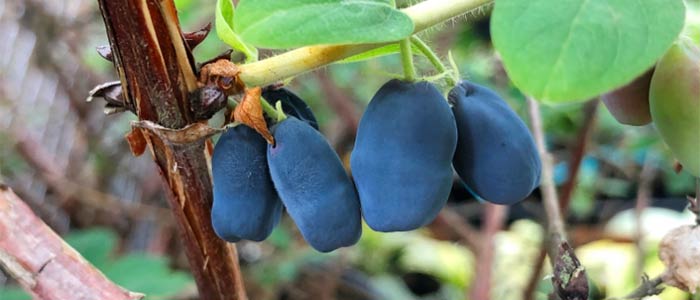- Shop
- Apparel
- Berries
- Books
- Bundles
- Citrus
- Fertilizer & Pest Control
- Fruiting Ground Covers
- Fruiting Shrubs
- Fruiting Trees
- Herbs, Spices, and Teas
- Mason Bees
- Nitrogen Fixers and Companion Plants
- Northwest Natives
- Nut Trees
- Ornamentals & More
- Perennial Vegetables
- Rootstock
- Subtropical Fruits
- Tools
- Vines
- Xeriscape
- Sale Items
- Information
- Nursery News
- Contact Us
- My Account

Honeyberry Planting Guide
Honeyberries are one of the first fruits to ripen in spring and are a wonderful early season treat. Even though they already have a long history of appreciation, these berries continue to be recognized for their benefits as a nutritional snack and for their value in the garden.
Insight into Growing Honeyberries
The Honeyberry (Lonicera caerulea) is an easy-to-grow fruiting shrub that thrives in cooler climates. Honeyberries are also known as Haskap Berries or Blue Honeysuckle Berries depending on their origin. They present beautiful white flowers in early spring followed by dark blue oblong berries. The berries take on the appearance of slightly stretched blueberries, however, they are more closely related to the Honeysuckle and are within the Caprifoliaceae family. They don’t require highly acid soil and can be planted in a pH between 4.5 – 8.5.
These shrubs can adapt to a wide range of soil types. They prefer more loam or clay soil but can still perform well being planted in more sandy locations. They can grow in either full or partial sun, however the berries produce best in a north facing location or with some shade in a southern area. Two or more different varieties are required to be planted nearby for cross-pollination and to ensure successful berry production.
Honeyberries require a cold dormancy period and are best suited for zones 3-8. Some varieties begin blooming as soon as early March. Even though gardeners in colder locations may be wary of their earlier bloom times, the flowers of these plants are exceptionally hardy surviving and thriving in temperatures as low as 20° F! Either early blooming and late varieties will grow well in cooler locations. Late blooming varieties may be more suited for those in warmer areas since fluctuations in temperature can impede on flower survival.
Honeyberry berries are becoming more and more recognized as a superfood! They are rich in Potassium, vitamin A, Vitamin C and have a significant concentration of anthocyanins which are a grouping of potent antioxidants responsible for the beautiful deep blue coloring of the berries along with providing positive health benefits when consumed.
The berries have a unique flavor and contain sweet-tart notes of huckleberry and blueberry with a floral touch. They can be eaten fresh or incorporated into smoothies, ice cream, desserts and baked goods. Presenting a Blue Honeysuckle pie at a dinner party is sure to turn some heads and pique some interest!
Experience all the benefits Honeyberries have to offer in your own garden by clicking HERE!
Early Bloom:
Cinderella, Berry Blue, Blue Belle, Blue Bird, Blue Lightning, Blue Nova, Blue Sky,
Honeybee, Indigo Gem, Indigo Yum, Tundra, Smokey Blue, Yezberry Maxie,
Yezberry Solo
Late Bloom:
Aurora, Blue Banana, Blue Forest, Blue Hokkaido, Blue Mist, Blue Moon, Blue
Pacific, Blue Pagoda, Blue Sea, Blue Velvet, Borealis, Boreal Beast, Boreal Beauty,
Boreal Blizzard, Giant’s Heart, Indigo, Kamchatka, Keiko, Pirika, Strawberry
Sensation, Taka, Tana
